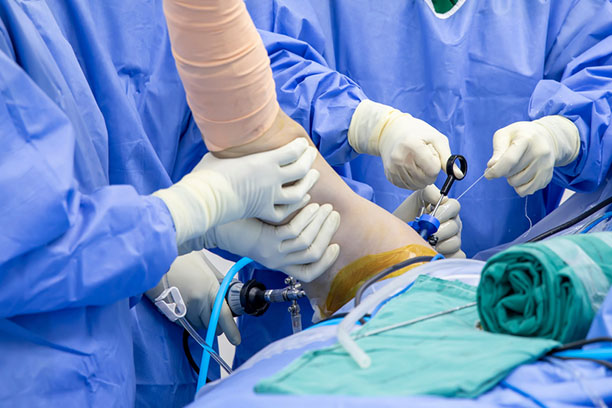Myths and Facts About Knee & Shoulder Arthroscopy, You Should Know
Arthroscopy is an exceptionally useful and minimally invasive surgical procedure used to diagnose and treat joint problems, primarily involving small incisions and the use of an arthroscope—an instrument equipped with a camera and light. During the procedure at Orthopedic hospital in Guntur, the surgeon inserts the arthroscope into the joint, allowing real-time visualization of the internal structures on a monitor. This technique provides a clear view of the cartilage, ligaments, and bones, facilitating precise diagnosis and targeted treatment such as removing loose fragments, repairing torn tissues, or smoothing damaged cartilage. Arthroscopy is commonly performed on joints like the knee, shoulder, elbow, ankle, and wrist, offering advantages such as reduced pain, minimal scarring, shorter recovery times, and lower infection risks compared to open surgeries. It is an invaluable tool in sports medicine, orthopedics, and rheumatology, enhancing the ability to manage joint conditions effectively while promoting quicker rehabilitation and improved patient outcomes.
Knee joint and arthroscopy !
Arthroscopy offers numerous benefits for knee joint management by providing a minimally invasive approach to diagnose and treat various conditions. It allows for direct visualization of the internal structures of the knee, including cartilage, ligaments, and menisci, enabling accurate diagnosis of injuries such as torn menisci or ligament tears. Arthroscopy facilitates the Best orthopedic doctors in Guntur for precise repairs or removals, such as meniscectomy or ligament reconstruction, promoting faster recovery and reduced post-operative pain compared to traditional open surgery. Additionally, it minimizes tissue damage, decreases infection risk, and results in smaller scars, which enhances cosmetic outcomes. Patients typically experience shorter hospital stays and quicker return to daily activities or sports. Arthroscopy also aids in the assessment of joint degeneration or instability, guiding further treatment plans. Overall, arthroscopy is a valuable tool in modern orthopedic practice, offering effective, less invasive options for managing knee joint problems and improving patient outcomes.
Articles List

Shoulder joint and arthroscopy
Arthroscopy offers numerous benefits for treating shoulder joint issues by providing a minimally invasive approach that reduces recovery time, minimizes scarring, and decreases the risk of complications compared to traditional open surgery. It allows for precise diagnosis and targeted treatment of conditions such as rotator cuff tears, shoulder impingement, labral tears, and dislocations. Using a tiny camera and specialized instruments inserted through small incisions, surgeons can visualize the interior of the shoulder joint in real-time, ensuring comprehensive assessment and effective repairs. Patients typically experience less postoperative pain, shorter hospital stays, and quicker return to daily activities and sports. Additionally, arthroscopy facilitates early mobilization and rehabilitation, promoting better functional outcomes. Overall, arthroscopy enhances the accuracy of shoulder joint interventions by Orthopedician in Guntur, improves patient comfort, and leads to more successful long-term results, making it a preferred approach for many shoulder pathologies.
Digging into the myths and facts:
- Myth: Arthroscopy is only for minor joint issues.
Fact: It is effective for both minor and complex joint problems. - Myth: Arthroscopy is bound to be followed by a long recovery.
Fact: Recovery time varies; many patients return to activities quickly. - Myth: Arthroscopy causes more damage than traditional surgery.
Fact: It’s minimally invasive with minimal or a very minuscule amount of tissue damage. - Myth: Arthroscopy is painful.
Fact: Anesthesia and pain management make it relatively painless. - Myth: Arthroscopy is suitable for all joint conditions.
Fact: Not all conditions are treatable with arthroscopy. - Myth: Arthroscopy guarantees a cure.
Fact: It may relieve symptoms but doesn’t always cure the underlying issue. - Myth: Arthroscopy is a recent innovation.
Fact: It has been used since the 1970s. - Myth: Arthroscopy is used only for the treatment of sports injuries.
Fact: It treats various joint problems in non-athletes too. - Myth: It is a risky procedure.
Fact: It is generally safe with low complication rates. - Myth: Arthroscopy always requires general anesthesia.
Fact: It can often be performed under anesthesia. - Myth: Arthroscopy leads to joint stiffness.
Fact: Proper rehab minimizes stiffness. - Myth: Arthroscopy is expensive.
Fact: Cost depends on various factors but most of the times can be lesser than an open surgery - Myth: Arthroscopy cannot be used for cartilage repair.
Fact: It is often used for cartilage procedures. - Myth: Arthroscopy will definitely improve joint motion.
Fact: Outcomes depend on the specific condition. - Myth: Arthroscopy is only for adults.
Fact: Pediatric cases also benefit by Best orthopedic surgeon in Guntur. - Myth: Arthroscopy always requires a hospital stay.
Fact: Many procedures are outpatient. - Myth: Arthroscopy causes significant scarring.
Fact: Incisions are small, resulting in minimal scars. - Myth: Arthroscopy can be performed even without administering any anesthesia.
Fact: Usually requires some form of anesthesia. - Myth: Arthroscopy is not suitable for severe joint degeneration.
Fact: It may be limited but still helpful in some cases. - Myth: Arthroscopy eliminates the need for physical therapy.
Fact: Postoperative rehab is crucial for optimal results.
How arthroscopy is transforming the scope of joints !
Arthroscopy is revolutionizing orthopedics by enabling minimally invasive diagnosis and treatment of joint conditions, significantly reducing patient recovery times and surgical risks. This technique involves inserting a small camera, called an arthroscope, into the joint, providing surgeons with high-definition, real-time visuals that enhance precision. It is particularly transformative for treating knee, shoulder, and ankle injuries, such as torn ligaments, meniscal tears, and cartilage damage. Arthroscopy's precision minimizes tissue damage, decreases postoperative pain, and shortens hospital stays, leading to quicker returns to daily activities and improved quality of life. Advances in arthroscopic technology, including improved camera resolution and specialized surgical tools, continue to expand its applications, making complex procedures more accessible and effective. Overall, arthroscopy by Orthopedic specialist in Guntur is shaping a new era in orthopedics by combining efficacy with patient-centered care, fostering faster recoveries, and enabling more accurate, less invasive interventions.
It may be time for your to consultant orthopaedic specialist
Consult an orthopaedic specialist when experiencing persistent or severe musculoskeletal issues such as ongoing joint, bone, or muscle pain that does not improve with rest or conservative treatments, especially if the pain is associated with swelling, deformity, or loss of function. Immediate consultation is warranted for fractures, suspected dislocations, or traumatic injuries. Consider seeing a specialist if you have chronic conditions like arthritis that worsen over time, or if conservative management, including physical therapy and medication, fails to alleviate symptoms. Additionally, if you experience unexplained numbness, weakness, or tingling in limbs, or if there is a noticeable deformity or instability in joints or bones, professional evaluation is crucial. Early intervention at Sree Sankalpa Multispeciality Hospital by an orthopaedic specialist, Dr. Chaitanya Ghanta can prevent complications, improve outcomes, and restore mobility, ensuring appropriate diagnosis and tailored treatment plans for complex or persistent musculoskeletal problems.
